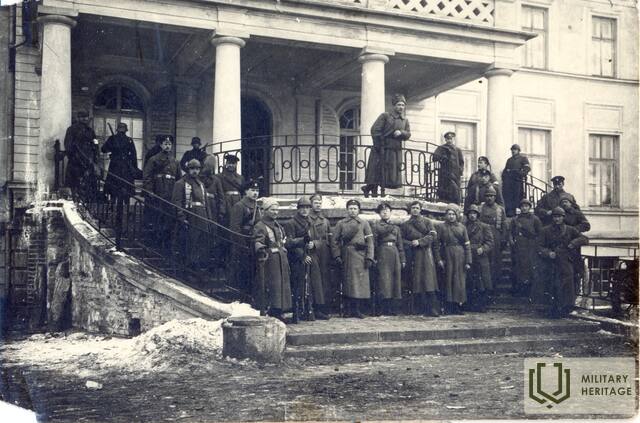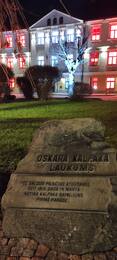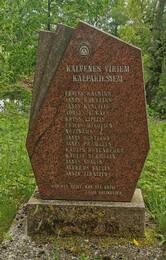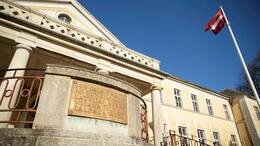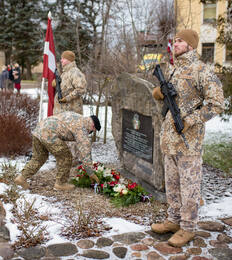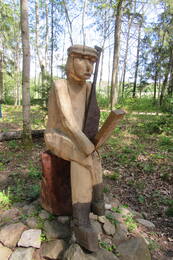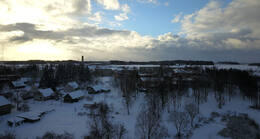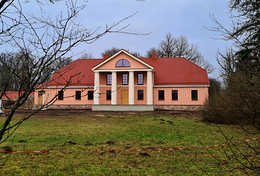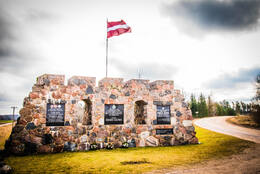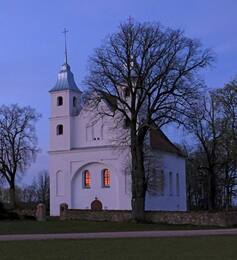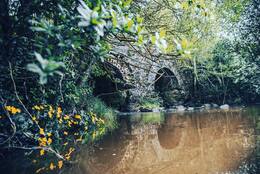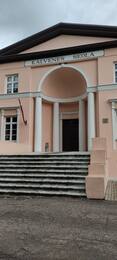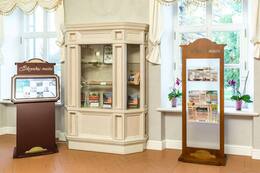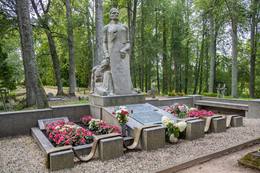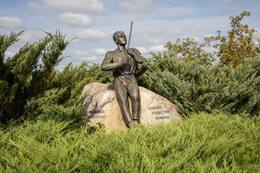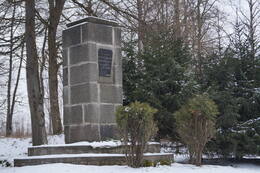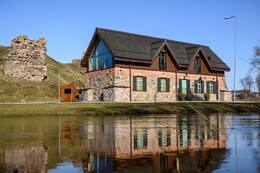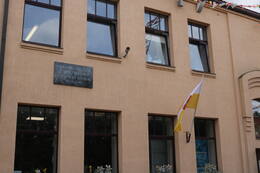Latvijos nepriklausomas batalionas
I Nepriklausomybės karai, I WW1, Baltijos šalių nepriklausomybė
Latvijos nepriklausomasis batalionas, dar žinomas kaip Kalpako batalionas (1919 m. sausio 5 d. – kovo 20 d.), buvo pirmasis Latvijos ginkluotas dalinys Laisvės kovų metu, priklausęs Latvijos nacionalinei gvardijai arba Baltijos landverui.
1919 m. kovo 21 d. Latvijos laikinoji vyriausybė išleido įsakymą pertvarkyti Latvijos nepriklausomąjį batalioną į Latvijos armijos grupę „Pietūs“, dar žinomą kaip Pietų Latvijos brigada.
Susijusi laiko juosta
Susijusios vietos
Memorial stone in Oskaras Kalpaka Square in Saldus
O. Kalpakos aikštė yra pačiame Saldaus centre, Lielā ir Striķu gatvių sankryžoje.
Buvusi turgaus aikštė šiandien yra mėgstama Saldaus gyventojų ir svečių poilsio vieta, kurioje rengiami koncertai, minėjimai ir šventės. 1919 m. kovo 10 d. Saldaus tapo pirmuoju Latvijos miestu, kurį išlaisvino pulkininko Oskaro Kalpako batalionas.
1919 m. kovo 14 d. aikštėje įvyko pirmasis Latvijos atskirojo bataliono paradas, o 1992 m., pulkininko Kalpako garbei, aikštė buvo pavadinta jo vardu.
Paminklas ir atminimo ženklai O. Kalpakos bataliono kariams Aizporės kapinėse
Maždaug pusiaukelėje tarp Rudbāržių ir Kalvės, seno kelio, lygiagretaus greitkeliui A9, pakraštyje yra Aizporės kapinės.
Aplinkiniuose namuose gyvenusiems Oskaro Kalpakos bataliono savanoriams kariams pastatytas paminklas ir 12 atminimo ženklų.
Kalvenės savivaldybės Aizporės pusdvaris buvo tolimiausia vieta, į kurią 1919 m. sausio 22 d. atsitraukė Latvijos atskirasis (Kalpakų) batalionas. Čia batalionas gavo pirmąjį pastiprinimą iš Liepojos – 35 vyrus ir pradėjo kontrpuolimą, sausio 24 d. pasiekdamas Rudbāržius.
Paminklo pastatymo idėja kilo dar 1920-aisiais, kai buvę 1-ojo Latvijos atskirojo bataliono, arba Kalpakos bataliono, kariai pastatė laikiną atminimo ženklą – ąžuolo luitą su lenta. Tuo metu gimė idėja sukurti didesnį memorialinį ansamblį, tačiau ji buvo įgyvendinta tik 1993 m. gegužės 15 d., kai buvo atidengtas atminimo ženklas – Šviesos spindulys – obeliskas iš pilko granito.
2,3 m aukščio atminimo ženklą sukūrė skulptoriai Harijs SPRINCIS ir Imants LUKAŽIS (1930–2007 m., palaidotas Aizpuri kapinėse), kurio tėvas taip pat buvo O. Kalpakos bataliono karys. Atminimo ženkle iškalti poeto E. VIRZOS vardai:
KALPAKAM
IR JO
KARIEMS
1919 m.
Sausio 25 d. rytas
NUO ŠIOS DIENOS
TAIP PAT IŠ
UGNIS
VIRŠ LATVIJOS
Tuo pačiu metu 12 kapinėse palaidotų Kalpų kapai buvo pažymėti ąžuolinėmis atminimo lentomis, kurios 2019 m. pakeistos granito žymekliais.
Dešimtojo dešimtmečio pradžioje kapinėse buvo pastatytas dviejų metrų aukščio paminklas, šalia kurio auga legendinio aktoriaus Ēvaldo Valterio dešimtojo dešimtmečio viduryje pasodintas ąžuolas.
Rudbāržių dvaro pilis ir 1-ojo Latvijos atskirojo bataliono atminimo lenta
Pilis yra Rudbāržuose, prie Rygos–Liepojos greitkelio A9. Priešais pastatą yra atminimo lenta, skirta Oskaro Kalpakos bataliono žygdarbiams atminti.
Pilis buvo pastatyta 1835 m. baronienės Theos von Firks įsakymu kaip baronų fon Firksų šeimos nuosavybė. 1905 m. gruodžio 15 d. dvaro rūmus sudegino revoliucionieriai. Po trejų metų prasidėjo restauravimo darbai, vadovaujami architekto L. Reinierso.
Latvijos nepriklausomybės karo metu Rudbāržių pilis tarnavo kaip bazė ir štabas koviniams veiksmams Ventos upės pakrantėje, kuriems vadovavo pulkininko Oskaro Kalpako 1-asis atskirasis Latvijos batalionas.
Vėliau pilis buvo naudojama kaip Latvijos armijos kareivių poilsio bazė. 1938 m. pilis buvo atstatyta.
Antrojo pasaulinio karo metu pastate buvo įsikūrusi vokiečių armijos kareivių ligoninė, o pokario metais – miško darbininkų mokykla. 1962 m. pilyje įsikūrė Rudbāržių mokykla, kuri 1991 m. buvo pavadinta Oskaro Kalpako vardu. Rudbāržių dvaro didvyrių salė buvo restauruota 2016 m. Šiuo metu mokykla uždaryta, tačiau ateinančiais metais pastate planuojama įkurti Oskaro Kalpako vardu pavadintą profesinę karo vidurinę mokyklą.
Skrundos mūšio memorialas ir vėliavos diena
Skrundos mūšio memorialas yra Skrundos centre, Oskaro Kalpakos parke netoli Skrundos kultūros namų, Kuldygos ir Liepojos gatvių sankryžoje. 2005 m. prie memorialo buvo pastatytas akmuo, skirtas 1919 m. sausio 29 d. mūšiui atminti, kai Oskaro Kalpako vadovaujamas batalionas kartu su vokiečių ir rusų Landesvero daliniais išvadavo Skrundą nuo bolševikų. Vėliavos dienos tradicija tęsiama nuo 2004 m., minint pirmąjį iš bolševikų išlaisvintą miestą ir jo išvaduotojus, kurie 1919 m. sausio 29 d. Skrundos bažnyčioje iškėlė Latvijos vėliavą.
Pirmaisiais Nepriklausomybės karo mėnesiais Latvijos laikinoji vyriausybė, spaudžiama bolševikų, sparčiai prarado teritoriją. 1919 m. sausio 22 d. bolševikai užėmė Skrundą. Po savaitės, sausio 29 d., ankstyvą rytą, prasidėjo puolimas Skrundai atsiimti. Latvijos atskirasis batalionas, vadovaujamas pulkininko leitenanto Oskaro Kalpako, turėjo pulti Rudbāržu-Skrundos plentu ir išstumti bolševikus iš Skrundos. Po to turėjo vykti vokiečių dalinių flanginis puolimas, kurio užduotis buvo sunaikinti artėjantį priešą, o rusų kuopa turėjo pulti tarp Latvijos ir Vokietijos dalinių, orientyru naudodama Skrundos bažnyčią. Puolimą taip pat rėmė vokiečių artilerijos baterija. Puolimo dieną buvo 15 laipsnių šalčio, švietė ryški saulė, kalpakai turėjo kirsti giedrą lauką, o bolševikai slėpėsi dvaro akmeniniuose pastatuose. Bolševikai atidengė ugnį, kai užpuolikų grandinė buvo nutolusi apie 300 metrų, kilo abipusis susišaudymas, ir Oskaro Kalpako vadovaujami kareiviai sparčiai puolė į priekį, priversdami priešą nutraukti ugnį ir trauktis per Ventą. Po maždaug 3 valandų kovos Skrunda buvo užimta apie 9 val. ryto, Latvijos atskirajame batalione buvo sužeisti tik 2 kariai.
Skrundos mūšis turėjo didelę reikšmę Latvijos laikinosios vyriausybės ginkluotų Speko karių moralei, nes tai iš tikrųjų buvo pirmoji reikšminga pergalė mūšiuose prieš bolševikus. Be to, pats vadas Oskaras Kalpakas mūšyje demonstravo ypatingą drąsą, savo pavyzdžiu skatindamas karius nebijoti.
Oskaro Kalpako muziejus ir memorialinė vieta „Airītes“
Oskaro Kalpako muziejus ir memorialinė vieta „Airītes“ yra tarp Saldaus ir Skrundos, netoli greitkelio A9. Parodoje pateikiama išsami informacija apie pulkininką Oskarą Kalpaką ir jo batalioną, taip pat pristatoma Latvijos nacionalinės armijos ir memorialinės vietos „Airītes“ istorija. Parodoje pulkininką Oskarą Kalpaką pristatoma kaip asmenybę, kaip karį ir kaip kovotoją už Latvijos nepriklausomybę. Parodoje taip pat yra garso įrašų latvių, anglų ir vokiečių kalbomis. Juose pabrėžiama 1918/1919 m. istorinių įvykių svarba saugant Latvijos valstybingumą. Muziejaus pastatas yra restauruotas.
Įėjimas nemokamas; ekskursija su gidu – mokama. Komplekse yra poilsio zona, parkas, kliūčių ruožas, galima lankyti įvairius užsiėmimus, yra seminarų salė iki 30 žmonių.
Oskaro Kalpako muziejaus „Gamtos ir stiprybės takas“
Gamtos takas buvo sukurtas greta muziejaus esančioje teritorijoje ir yra paremtas 1936 m. O. Kalpako muziejaus ir jo aplinkos projekto idėja. Individualūs muziejaus lankytojai gamtos taku gali naudotis nemokamai.
Gamtos take eksponuojamos Kuldygos technologijų ir turizmo technikumo organizuoto medžio apdirbėjų plenero, kurio jungianti tema – „Už meilę laisvei“, metu sukurtos medinės skulptūros. Taip pat eksponuojami didelio formato paveikslai iš plenero „Saugok savo Tėvynę!“, kuriuos nutapė aplinkinių regionų moksleivių komandos.
Gamtos take taip pat įrengtas mini oro takelis jauniausiems muziejaus lankytojams.
Jaunmuiža ir 1-asis Latvijos atskirasis batalionas
Šiandien Jaunmuiža, anksčiau Jaunāmuiža, yra apgyvendinta vieta Kuldygos savivaldybėje, esanti prie Skrundos–Ezerės kelio, 7 kilometrų atstumu. Gyvenvietė buvo įkurta buvusių Jaunos dvaro (Neuhof) pusrūmų vietoje.
1919 m. kovo 3 d. dėl šios vietos vyko įnirtingos kovos tarp pulkininko Oskaro Kalpako vadovaujamo 1-ojo Latvijos atskirojo bataliono ir 2-ojo sovietų Latvijos šaulių pulko dalinių.
1919 m. kovo 3 d. prasidėjo Kuršo išlaisvinimo operacija „Tauwetter“ („Atlydys“), kurios metu Vokietijos armijos VI rezervinis korpusas su Landesveru ir jo 1-uoju Latvijos batalionu pradėjo puolimą per frontą, siekdami nustumti bolševikų dalinius į Lielupę. Kovo 3 d. ankstų rytą 1-ojo Latvijos atskirojo bataliono – Cėsių kuopos, Studentų kuopos ir kavalerijos divizijos – daliniai, sustiprinti vokiečių hauptmano Müllerio artilerijos baterijos, perėjo Ventą ties Lėnais ir puolė Jaunų dvarą, kurį gynė 2-ojo sovietų Latvijos šaulių pulko 2-asis batalionas. Kelias valandas trukusio mūšio metu, palaipsniui užimdami namus Jaunosios muižos apylinkėse, Kalpakos vadovaujami daliniai pasiekė Jaunąją muižą ir perėmė Skrundos–Pampalių plentą, nutraukdami priešo judėjimą ir stumdami priešą į rytus. Jaunosios muižoje batalionas kaip trofėjus gavo kanceliarinių prekių ir šaudmenų. Užimdamas pozicijas netoliese esančiuose namuose, batalionas įsitvirtino. Kovo 5 d. prasidėjo bolševikų kontrataka, kuri vakare buvo sustabdyta. Kovo 6 d. batalionas atnaujino puolimą, užėmė Skrundos mokyklą ir žygiavo Airitės-Aizupjų apylinkių link.
Lėtas dvaras
Dvaro pilis yra Lėnų kaime, prie Ventos upės. Šiuo metu pilis yra privati nuosavybė, todėl ją galima pamatyti tik iš tolo.
Dvaro rūmai nuo 1919 m. sausio pabaigos iki kovo 3 d. buvo naudojami kaip 1-ojo Latvijos atskirojo bataliono atramos punktas. Latvijos atskirasis batalionas turėjo išlaisvinti Leni dvaro apylinkes, kad galėtų kirsti upę priešais Jaunmuižą.
Dvaras priklausė baronui Friedrichui von Firksui, kuriam taip pat priklausė Rudbāržzi ir Sieksate dvarai. Dvaro rūmai buvo pastatyti XIX a. Baronui Lēnu pilis daugiausia tarnavo kaip medžioklės ir savaitgalio poilsio vieta.
Nuo 1927 iki 1937 m. pilyje veikė mokykla, o sovietų okupacijos metu – kolūkio medienos dirbtuvės. 1965 m. atidarytas bendruomenės centras. Pastatų ansamblis buvo daug kartų pertvarkytas, o parkas neišsaugotas. Išliko keli ūkiniai pastatai.
1-ojo Latvijos atskirojo bataliono memorialas Lėnuose ir perkėlimo vieta prie Ventos upės
Paminklas yra Lėniuose, kelių sankryžoje netoli Lėnių dvaro.
Paminklas atidengtas 2007 m. lapkričio 8 d. Jį sukūrė skulptorė Maija Engele. Paminklo autorius ir finansuotojas yra Janis Blūms, kurio tėvas leitenantas Paulis Blūms, 1-ojo atskirojo Latvijos bataliono kavalerijos divizijos pirmasis leitenantas, 1919 m. kovo 3 d., padedamas 10 vyrų, organizavo ir vadovavo upės perėjimui.
Kasmet kovo 3 d. čia susirenka jaunieji sargybiniai, kariai ir kiti susidomėję asmenys, vykstantys 1-ojo Latvijos atskirojo bataliono pagerbimo renginyje.
Švenčiausiosios Trejybės Romos katalikų bažnyčia Lėni mieste
Bažnyčia yra Lēnu kaime, Nīkrāce parapijoje, Skrundos savivaldybėje, prie kelio Skrunda – Embute.
Netoli bažnyčios teka Ventos upė, kurios krantus 1919 m. vasarį saugojo 1-ojo atskirojo Latvijos bataliono kariai. Kadangi bataliono karių skaičius neleido sukurti ištisinės fronto linijos, frontą saugojo sargybos postai. Vienas iš jų taip pat buvo įsikūręs upės krante netoli bažnyčios. Bažnyčios bokštai buvo naudingi stebint apylinkes ir kitą upės pusę.
Mūšis Skrundos mokykloje
Skrundos mokykla yra Pumpuruose, Skrundos–Ežerės kelio 3 km. Mokykla yra privati, todėl ją galima pamatyti iš tolo.
1919 m. sausio ir kovo mėnesiais 1-asis Latvijos atskirasis batalionas netoli mokyklos kovėsi su Sovietų Latvijos 2-ojo Latvijos šaulių pulko daliniais.
Mūšis prie Skrundos mokyklos įvyko 1919 m. sausio 22 d. Susidūrę su besitraukiančia bolševikų persvara, vokiečių ir latvių daliniai išsidėstė vakariniame Ventos krante, o bolševikų pajėgos, ruošdamosi platesnei operacijai, susirinko Salduse, tuo pačiu metu siųsdamos dalį savo pajėgų Skrundos kryptimi. Siekdamos perimti iniciatyvą ir pabandyti dalimis nugalėti bolševikų pajėgas, sausio 22 d. 1-ojo Latvijos atskirojo bataliono Cėsių kuopa, sustiprinta 15 karininkų kuopos ir vokiečių Radeno kuopos, dislokuotos Skrundos fronto sektoriuje, karių, turėjo pulti Salduse. Abiejų kuopų susibūrimo vieta buvo paskirta Skrundos mokykla. Tačiau parengiamajame puolimo etape abi kuopas užklupo bolševikų puolimas, priversęs vokiečių ir latvių dalinius trauktis į Rudbāržius.
Antrasis susirėmimo Skrundos mokykloje etapas įvyko 1919 m. kovo 6 d., kai pulkininko Oskaro Kalpako vadovaujamo bataliono Cėsių ir Studentų kuopos užklupo priešą, užėmė Skrundos mokyklą ir toliau žygiavo Dutėnų, Engurniekių ir Airytės link.
Skrundos–Ežerės kelio pakraštyje, netoli mokyklos, kur kelias kerta Klūgos upę, yra nedidelis, senovinis XIX a. pabaigos akmeninis tiltas su dviem puslankiais, skirtas upei pratekėti. Kelias, vedantis per tiltą, anksčiau buvo naudojamas, tačiau dabar pamažu apauga žole, nes naudojamas greta esantis asfaltuotas kelias ir tiltas. Nuo šio tilto atsiveria nuostabus vaizdas, kurį praturtina uolėta upės vaga ir tankiais medžiais apaugę krantai. Vietovė vizualiai labai patraukli ir tinkama dviračių ar pėsčiųjų maršrutams.
Tašas - Padurės dvaras
Tasi-Padurės dvaro pilis dabar žinoma kaip Kalvenes pradinė mokykla, įkurta 1922 m. Mokyklos pastatas buvo pastatytas XIX a. vėlyvojo klasicizmo stiliumi kaip grafo Keizerlingo medžioklės namelis.
1919 metų pradžioje čia susirinko ir į dvarą atvyko pirmieji į mobilizacijos šaukimą atsiliepę mobilizacijos vyrai. 1919 metų sausio 22 dieną čia buvo įkurtas Latvijos atskirasis kavalerijos dalinys, kurio vienas vadų sausio 24 dieną išvyko į O. Kalpakso vadovaujamą 1-ąjį Latvijos atskirąjį batalioną. Visas dalinys (iš viso apie 80 kareivių), vadovaujamas vado Arnoldo Artumo-Hartmanio, į Rudbāržius atvyko kovo 1 dieną.
Kalvenės pradinė mokykla yra nacionalinis kultūros paminklas. 1960-aisiais pilis buvo renovuota ir pritaikyta mokyklos poreikiams.
Skrundos dvaras ir Skrundos lokatoriaus ekspozicija
Skrundos dvare įrengta ekspozicija apie Skrundos radarą (Skrundos radijo lokacijos stotį) ir Latvijos liaudies fronto veiklą Skrundoje. Skrundos radijo lokacijos stotis, pravarde „Kombināts“ (Gamykla), buvo SSRS raketų ankstyvojo perspėjimo sistema vakariniame sektoriuje. Vietovė „Skrunda-2“ buvo specialus miestas (V/ч 18951), įkurtas 5 km nuo Skrundos Kuldygos kryptimi SSRS kariuomenės reikmėms. Iš čia veikė radaro stotis „Dnepr“ ir buvo statoma nauja, modernesnė stotis „Darjal“. Statybos buvo sustabdytos, o radaro stotis „Darjal“ susprogdinta 1995 m. gegužės 4 d. Laikantis tarptautinio susitarimo, radaro stotis „Dniepras“ buvo uždaryta 1998 m. rugpjūčio 31 d.
Pulkininko Oskaro Kalpako amžinojo poilsio vieta
Įsikūręs Visagalos kapinėse, Madonos apskrityje
Eksponuojamas Oskaro Kalpako paminklas, atidengtas 1927 m. liepos 10 d., Kārlio Zālės ir Arnoldio Dzirkalio – trijų figūrų kompozicija, kurios centre pavaizduotas senovės latvių karys su skydu ir kardu rankose, o abiejose jo pusėse stovi du kariai. Skulptūrinės grupės papėdėje ant granito pagrindo įstrižai pritvirtinta bronzinė lentelė, kurioje išgraviruotas tekstas, kuriame yra ir Edvardo Virzos eilėraštis, skirtas Kalpakui.
Oskaras Kalpakas žuvo 1919 m. kovo 6 d. netoli „Airītē“, Skrundos–Saldus kelio pakraštyje, o jo palaikai rugsėjo 18 d. iš Liepojos šiaurinių kapinių buvo perkelti į šeimos kapines Visagaloje.
Paminklą atidengė pulkininko O. Kalpako paminklo komiteto pirmininkas generolas J. Balodis, dalyvaujant tuometiniam Respublikos prezidentui G. Zemgalui, ministrui pirmininkui M. Skujeniekui, Saeimos pirmininkui P. Kalniniui, karo ministrui R. Bangerskiui ir K. Ulmaniui. Paminklo kertinis akmuo buvo padėtas 1925 m. birželio 19 d. Paminklo akmuo buvo paimtas iš pulkininko gimtųjų namų Sienos pelkėje, ant šio akmens O. Kalpakas vaikystėje mėgo groti smuiku.
Pulkininko Oskaro Kalpako „Liepsalos“ gimtinė ir amžinojo poilsio vieta Visagalo kapinėse
Pulkininko Oskaro Kalpako šeimos memorialas Liepsaluose yra Maduonos ir Lubano ežero teritorijoje. Liepsalas yra Kalpako vaikystės namai. Memorialinė vieta čia buvo įkurta 1997 m., remiantis pulkininko dukterėčios Ārijos Kalpako-Grundmanės (1922–2006) idėjomis ir panaudojant jos išteklius. Vietovėje eksponuojami įvairūs aplinkos objektai ir akmens skulptūros, turinčios simbolinę reikšmę, perteikiančios Latvijos etines ir patriotines vertybes. Didžiausiame pastate įrengta ekspozicija, skirta Latvijos nepriklausomybės karo istorijai ir 22 Latvijos laisvės metams (1918–1940). Visagalo kapinėse esantis Oskaro Kalpako paminklas, kurį sukūrė Kārlis Zāle ir Arnolds Dzirkals, buvo atidengtas 1927 m. Paminklą sudaro trijų figūrų kompozicija, kurios centre – senovės latvių karys, laikantis skydą ir kardą, o iš abiejų pusių – po krintantį karį. Skulptūrinės grupės papėdėje ant granito pagrindo įstrižai pritvirtinta bronzinė lentelė su išgraviruotu tekstu, įskaitant Edvardo Virzos Kalpaksui skirtą eilėraštį. Oskaras Kalpaksas mirė 1919 m. kovo 6 d. netoli Airytės, prie kelio iš Skrundos į Saldų.
Oskaro Kalpako bataliono pirmajam mūšiui skirtas paminklas Lielaucėje
Paminklas pirmajam Oskaro Kalpako bataliono mūšiui atminti stovi prie Lielaucės liuteronų bažnyčios griuvėsių. Jis pastatytas toje vietoje, kur naktį iš 1919 m. sausio 15 d. į 16 d. įvyko pirmasis svarbus Kalpako bataliono mūšis. Tą naktį dvi Kalpako bataliono kuopos atrėmė viso bolševikų bataliono ir kavalerijos eskadrono puolimą. Kadangi Landesveras pralaimėjo mūšį Aucėje, buvo nuspręsta atsitraukti ir laikyti frontą prie natūralios kliūties – Ventos upės.
Paminklas buvo atidengtas 1934 m. rugpjūčio 19 d., dalyvaujant buvusiam Kalpako bataliono kariui, žemės ūkio ministrui J. Kauliniui. Paminklo autorius – architektas P. Dreimanis, o pastatė J. Sierinis. Paminklas pastatytas iš pilko granito blokų, o jo priekyje pritvirtinta juodo granito lenta su užrašu: „Čia 1919 m. sausį iš 15 d. į 16 d. įvyko pulkininko Kalpako bataliono mūšis.“ Per šį mūšį žuvo keturi kariai.
XX a. 6. deš. pradžioje paminklas buvo sunaikintas, o lenta sudaužyta. 1991 m. jis buvo atstatytas, panaudojant originalią lentą, kuri buvo perskelta į dvi dalis. Atstatytame paminkle lenta yra nebe iš bažnyčios pusės, o atsukta į Lielaucės centrą.
Laisvosios valstybės brangenybių namai
Nepriklausomos valstybės palikimą saugantys namai yra šalia Rėzeknės pilies griuvėsių.
Išskirtinėje ekspozicijoje pristatoma keli šimtai istorinių eksponatų iš Latvijos ir užsienio privačių kolekcijų, apimančių 1918–1940 m. laikotarpį, bei skirtingus Latgalos ir Rėzeknės istorijos puslapius. Supažindinama su Pirmosios nepriklausomos Latvijos valstybės karinių ir civilinių apdovanojimų istorija, įvairių valstybinių ir visuomeninių organizacijų veikla, vykusia nuo Latvijos nepriklausomybės karo iki Antrojo pasaulinio karo.
Tai didžiausia Latvijoje kolekcija, pristatanti nepriklausomos valstybės karinius ir civilinius apdovanojimus bei skiriamuosius ženklus.
Antrajame aukšte įrengta keičiamų parodų salė, kurioje bent kartą per metus surengiama nauja paroda. Lankytojai jau turėjo galimybę pamatyti išskirtinę porceliano dirbinių kolekciją, prabangius laikrodžius iš Prancūzijos ir įvairius Latgalos peizažus vaizduojančius paveikslus.
Atminimo lenta prie namo, kuriame buvo įkurtas atskirasis Bauskės batalionas
Atminimo lenta prie namo, kuriame buvo įkurtas atskirasis Bauskės batalionas, yra pagaminta iš juodo švediško granito, kuri buvo atidengta 1935 m. balandžio 22 d. tuometiniuose Ūkininkų kredito unijos namuose. Atminimo lentą įrengė Bauskės savivaldybė kartu su miesto visuomeninėmis organizacijomis. Pirmaisiais komunistinės okupacijos metais name buvo įsikūrusi čeka ir milicija. 1941 m. balandžio mėn. Bauskės milicijos ir čekos viršininko įsakymu šaltkalvio Valdorfo mokinys pradėjo naikinti lentą, tačiau, norėdamas ją išsaugoti, numušė tik apatinį dešinįjį kampą, o paskui pareiškė, kad jos sulaužyti neįmanoma. Jis rekomendavo lentą nudažyti baltais kalkiniais dažais, kas ir buvo padaryta. Išvijus bolševikus, dažai buvo nuplauti, bet jiems sugrįžus, lenta buvo perdažyta dar kartą. Atgimimo metu ji vėl buvo nuvalyta. Pats pastatas buvo iš dalies sunaikintas 1944 m. karo metu. Šiandien pastatas yra renovuotas, išsaugant istorinius matmenis. Pastate įsikūrusios komercinės įstaigos, o iš istorinio interjero nieko neišliko. Pastatą galima apžiūrėti tik iš išorės.
Atskiras Bauskės batalionas buvo suformuotas Bauskėje 1919 m. balandžio 24 d. Bauskėje dislokuotų vokiečių pajėgų vadas neprieštaravo latvių mobilizacijai ir bataliono formavimui, remiantis Latvijos vyriausybės balandžio 22–24 d. paskelbta visuotine mobilizacija. Į mobilizaciją atsiliepė apie 300 piliečių, buvo suformuotos trys kuopos. Kuopų vadais buvo paskirti Latvijos karininkai, tačiau bataliono vadovavimas iš pradžių buvo patikėtas vokiečių leitenantui Bettiheriui, kurį tik gegužės pabaigoje pakeitė Latvijos karininkas kapitonas V. Kevei-Gudže. Kurše dislokuotų vokiečių kariuomenės vadas Rüdiger von der Golz uždraudė batalionui būti pavaldžiam pulkininko Jānio Baložo vadovaujamai Latvijos atskirai brigadai, ir jis buvo prijungtas prie vokiečių 1-osios gvardijos rezervinės divizijos junginių, įskaitant Brandio diviziją, kuri tuo metu gynė Bauskę. Balandžio 28 d. bolševikai pradėjo puolimą prieš Bauskę. Tuo metu batalionas buvo ginkluotas tik 50 vyrų būriu, kuris dalyvavo mūšyje. Šiam daliniui pavyko išstumti bolševikus iš Derpeļmuižos, užkertant kelią kritinei situacijai ir sustabdant priešo puolimą. Iškart po mūšio visas batalionas buvo apginkluotas, tačiau vokiečiai vis tiek neaprūpino jo automatiniais ginklais. Pirmuosius kulkosvaidžius batalionas gavo kaip trofėjus kovoje su bolševikais gegužės 1 ir 2 dienomis. Naujus trofėjus, taip pat 27 belaisvius, bataliono žvalgybos grupė gavo gegužės 11 d. Pērkoniškio kaime Lietuvos teritorijoje.
Gegužės 18 d., prasidėjus naujam didelio masto bolševikų puolimui prieš Bauskę, batalionas buvo užėmęs pozicijas Mūsos upės krantuose priešais Ceraukstės dvarą, kur atrėmė visus priešo atakas. Gegužės 22 d. išvijus bolševikus iš Rygos, bataliono koviniai veiksmai šiame fronto sektoriuje taip pat baigėsi. Į Latgalos frontą batalionas atvyko rugpjūčio 5 d., kur užėmė pozicijas Rubenės-Izabelinos linijoje, tačiau jau 1919 m. rugpjūčio 16 d. buvo įtrauktas į naujai suformuotą 3-iąjį Jelgavos pėstininkų pulką kaip 2-asis batalionas.
Pirmasis Lielaucės pilies ir Oskaro Kalpako bataliono mūšis
Lielaucės dvaras su parku – objektas, Latvijos istorijoje siejamas su Pirmuoju Kalpako mūšiu, įvykusiu Nepriklausomybės karo metu 1919 m. sausį, ir jo pergale. Dabartinis dvaro pastatų ansamblis iš esmės susiformavo XIX a. pradžioje. Dvaro rūmai iš pradžių buvo statomi imperijos stiliumi kaip dviejų aukštų pastatas su čerpių stogu. Komplekso ūkiniai pastatai yra atokiau nuo dvaro parko. Išliko valdytojo namas, kuris vėliau buvo perstatytas į kultūros centrą, arklidės, tarnų namas ir ledo rūsys tvenkinio pusėje. Išliko tik 1801 m. statyto klėtis pamatai, tačiau kūginės krosnies tūriai, nors ir atstatyti, yra gerai išsaugoti. Taip pat galima apžiūrėti dvaro vežiminę arba kareivių tvartą.
Įkūrus Latvijos valstybę, Lielaucės dvaro pastatas su gretimu ežeru, parku, pastatais ir tam tikru miško plotu pirmiausia buvo perduotas vaikų namams įkurti, tačiau jie nebuvo įkurti. 1926 m. lapkritį Latvijos universiteto Žemės ūkio fakulteto Miškų ūkio katedra perėmė Centrinio žemės komiteto suteiktą Lielaucės pilį su parku ir 59 hektarų žemės sklypu, skirtu mokomiesiems užsiėmimams organizuoti. Po Antrojo pasaulinio karo, iki 2009 m., čia veikė Lielaucės pradinė mokykla, o tuo pačiu metu – ir LLU aptarnavimo viešbutis. Šiuo metu dvaras ir parkas priklauso SIA „Mudia“. Kol nebus pagerinta dvaro techninė būklė, jis lankytojams neprieinamas.
1919 m. sausio 15 d. naktį Kalpako batalionas kovėsi pirmajame mūšyje Lielaucėje, atremdamas raudonųjų puolimą. Tai buvo pirmasis reikšmingas Kalpako bataliono mūšis, kai pergalė suteikė kariams ypač stiprų moralinį postūmį.
Atsitraukimo metu, sausio 12 d., Latvijos atskirasis batalionas pasiekė Lielaucės dvaro pilį ir ten įsikūrė pailsėti, įrengdamas sargybos postus aplinkiniuose keliuose. Ankstyvą sausio 16 d. rytą sargybiniai pastebėjo artėjantį priešą Duobelės plentu ir spėjo įspėti pilyje buvusius asmenis. Pirmieji į mūšį įsitraukė Karininkų rezervo kuopa, užėmusi pozicijas prie dvaro pastato. Cėsių kuopa, padalinta į dvi dalis, bandė apsupti priešą. Iš pradžių bolševikai atsitraukė, bet vėliau pradėjo kontrataką, kurią Cėsių kuopai pavyko atremti. Priešas buvo priverstas trauktis. Iškovota pirmoji pergalė prieš bolševikus. Nors kalpakiečiai patyrė keturis nuostolius (leitenantas Kārlis Dambītis, leitenantas Fridrihs Liepa, karo raštininkas Vilis Cīrulis ir instruktorius Jānis Būvmeistars) ir aštuonis sužeistuosius, mūšio baigtis paskatino karius tęsti kovą su priešu. Deja, tą pačią dieną Latvijos atskirasis batalionas buvo priverstas palikti savo pozicijas, nes vokiečių Raedeno kuopa pralaimėjo mūšį prie Vecaucės ir atsitraukė.
Susijusi istorija
Generolo Ridiger von der Goltz vizitas į Rudbārži 1919 m. vasario mėn
1919 m. vasarį, po sėkmingos antivokiškos kampanijos Suomijoje, vokiečių generolas Ridiger von der Goltz buvo paskirtas vokiečių ginkluotų junginių Kurše ir Šiaurės Lietuvoje, įskaitant Landwehrą, kuriam priklausė ir 1-asis Latvijos batalionas, vadu. Vizito fronte metu 1919 m. vasarį jis taip pat atvyko į Rudbāržius. Bataliono specialiųjų užduočių karininkas leitenantas Jānis Ķīselis aprašė generolo vizitą savo memuaruose.
1-asis Latvijos atskirasis batalionas perplaukė Ventą 1919 m. kovo 3 d.
Vienas pagrindinių 1-ojo Latvijos atskirojo bataliono dalinių iššūkių buvo kirsti užšalusią Ventos upę ir nutiesti kelią per ją.
Kapitono Aleksandro Levingo prisiminimai apie žvalgybinę ekspediciją virš Ventos netoli Leno
1919 m. vasarį abiejose Ventos upės pusėse vyko aktyvi žvalgyba. Vienas iš žvalgybinių reidų vadų buvo kavalerijos divizijos viršininkas kapitonas Aleksandras Loevingas.
Skrundos mokyklos mūšis 1919 m. sausio 22 d.
Vado leitenanto Janio Ķīselio prisiminimai apie kautynes Skrundos mokykloje 1919 m. sausio 22 d.




